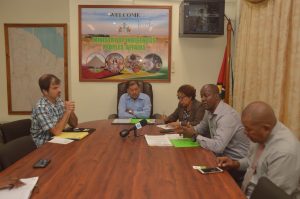THE Ministry of Indigenous Peoples’ Affairs (MoIPA) on Wednesday (February 20, 2019) inked a Memorandum of Understanding (MoU) with the Ministry of Business (Guyana Tourism Authority [GTA]) to promote community-based tourism in four communities in the hinterland, at the ministry’s boardroom, Thomas Street, Georgetown.
In giving a brief background of the GTA and MoIPA collaboration agreement, Permanent Secretary Alfred King told reporters that the intention was to empower hinterland communities to take responsibility for their own development and livelihood.
He added that part of what the ministry does included the promotion of sustainable businesses, among which are nature-based tourism activities.
King stated that when GTA Director, Brian Mullis, approached the MoIPA about the initiative, it was quickly agreed that a partnership should be established. Many meetings were held and a MoU was conceptualised.
The PS of MoIPA pointed out that the signing of the MoU would see both agencies entering into a more structured agreement where their roles and responsibilities would be laid out.
King said, “The ministry wants to do more to enhance these tourism projects that we are embarking on and from a policy standpoint, how the ministers will want to continue to focus some attention and give better direction to ensure that these tourism packages grow and develop into real sustainable activities.”

During remarks, Minister of Indigenous Peoples’ Affairs and 4th Vice President, Sydney Allicock, said that the MoU signalled the development of tourism, more so, in indigenous communities to enhance the social and economic welfare of the people and their lands through sustainable development. He further stated that the hinterland was where real life was. He noted the hinterland’s natural beauty, flora and fauna, as well as its pristine forest, all in keeping with the government’s green state initiative.
The minister added that the agreement (MoU) was geared toward the development of the hinterland people’s human and financial resources for maximum output with resources at hand.
The minister said “With the GTA as a partner, they have the expertise to provide training to the people of the hinterland and it was best to pool their resources to achieve community-based tourism with lots of nature activities.”
Allicock noted that Guyana was ‘undiscovered’ and, although it may be difficult to provide five-star accommodation, the country could-provide five and ten-star forests.
He pointed out that community-based tourism was aimed at exploiting the environment without doing harm.
Meanwhile, Minister Valarie Lowe said it was a good moment for them since the ministry believed in collaboration, that is, working with agencies to ensure that hinterland communities developed strategically.
She explained that to cater for 78,000 or 80,000 people which was about 11%-12% of the population in the hinterland communities, was quite a challenge for the ministry, thus the need to collaborate to develop the communities.
Lowe said “The ministry is working to address the 2030 sustainable goals with women to get rid of poverty, enhancing the lives of youths, providing potable water supply, among other things in the hinterland communities.”
She pointed out that within the communities, the hinterland has been a challenge for them, for a long time with various governments and they were politically ready to reach out to the people, to address all their issues and concerns.
Lowe told reporters that it was the duty of the government to have a schools etc., and the government had reached out more to the economic needs of the people.
The minister also alluded to the fact that the Hinterland Employment and Youth Services (HEYS) project allowed youths to be trained in life skills to enhance their lives to earn meaningfully.

She said, “We found cattle rearing is very successful, when you look at eco-tourism, how we can develop Guyana, the coast is just a strip, the hinterland is our beauty, use it to develop it and keep it intact as well as educate our people.”
The people in the hinterland are very educated and the ministry, through the GTA, is marketing the hinterland which the minister described as Guyana’s 2nd oil.
GTA Director, Brian Mullins, told the media that the hinterland had a great deal of pristine forest and savannahs and those were what people were attracted to.
He stated that travellers appreciate pristine nature and Guyana could provide the ideal experience for travellers, in nature and exploration, through the lands in the hinterland communities, via tourism.
Mullins said community-based tourism was phenomenal in Guyana and it needed to be promoted through partnerships, by all private sector agencies, to maximise resources in the communities of Moraikobai, Chenapau, Karasabai and Warapoka.



.jpg)









